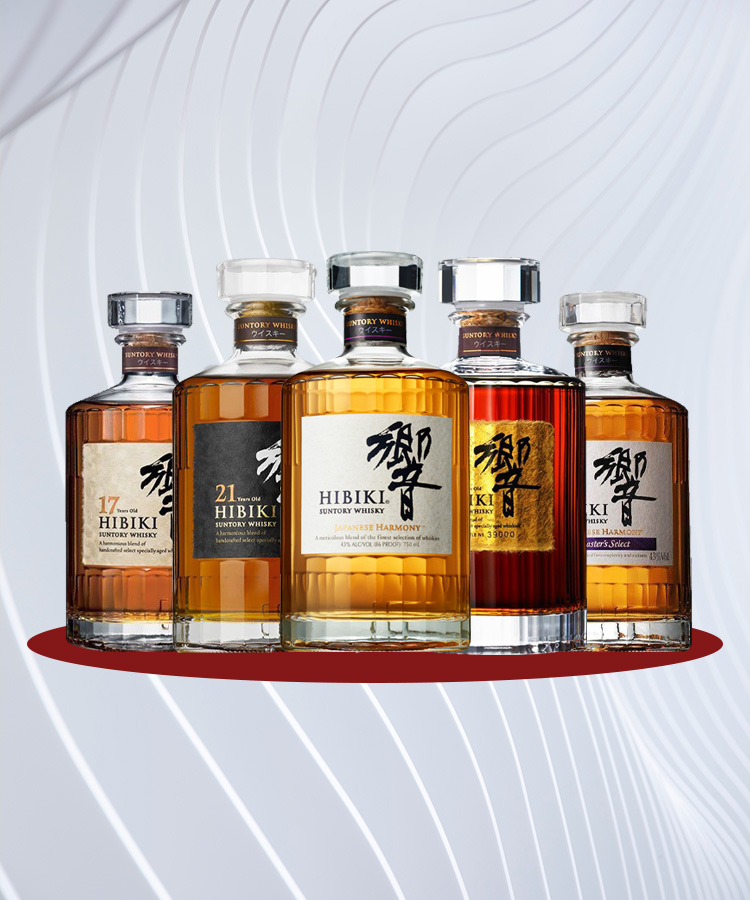
We are, thankfully, decades beyond the time when Japanese whisky was considered a novelty. Today, spirit connoisseurs the world over uphold Japanese whisky as a shining example of what the category can do.
Many factors make Japanese whisky exceptional in a world where whisky production has grown ever more global, but perhaps none stands out as much as blending. Japanese makers have shown a special reverence and propensity for this delicate art, and perhaps no better expression of this national talent exists than the House of Suntory’s legendary Hibiki range.
Hibiki — which translates to “resonance” in Japanese — was conceived in 1987 by Master Blender Keizo Saji, who wanted to create a whisky that would showcase the blending ethos of the House of Suntory in time for the company’s 90th anniversary in 1989. To create the blend, Suntory’s chief blender Koichi Inatomi embarked on the near-Sisyphean task of sampling the finest aged malt whiskies Suntory had to offer: a quest that ultimately saw Inatomi tasting from one million casks over a long period of time.
Following this monumental tasting effort, Inatomi and Saji narrowed the blend down to a core of 30 malt and grain whiskies developed within the Suntory distilleries; this led to the creation of what became the first installment in the Hibiki series. To assure its continued excellence, Suntory’s master blender dedicates time each day to sample different malt whiskies, ensuring each one meets House of Suntory’s high standards.
Exploring the Five Expressions of Hibiki
Today, the full Hibiki range consists of five expressions that are as unique as their blends: Hibiki Japanese Harmony, Hibiki Japanese Harmony Master’s Select, Hibiki 17 Years Old, Hibiki 21 Years Old, and Hibiki 30 Years Old. While the contents of each vary, they share in common Suntory’s total devotion to the art of blending and a unique bottle design inspired by the traditional Japanese calendar.
In contrast to the 12-month, four-season calendar model in widespread use today, the traditional Japanese calendar consists of 24 distinctly defined seasons. Such a division makes it possible to focus on and better enjoy the intricacies of the seasons as they change, and this ethos has a direct link to the art of blending that makes Hibiki possible. It is only by focusing on the immeasurable complexities and intricates of the whiskies used to create Hibiki that the final blend becomes possible.
As a tribute, each of the five expressions that constitute the Hibiki range is presented in a specially designed decanter bottle with 24 sides — one for each of the traditionally understood Japanese seasons. This, however, is not the only feature of the bottle’s design that calls back to Japanese culture. A band of deep purple — considered by Japanese tradition to be the noblest of colors — is found around each bottle’s neck.
Since its introduction more than 30 years ago, Hibiki has earned many awards in the whisky category. Each expression in the series earned a “Gold Award” during the 2020 International Spirits Challenge, and Hibiki 21 Years Old was named “World’s Best Blended Whisky” at the 2019 World Whiskies Awards.
To better understand how the Hibiki range has earned such national and international acclaim, it’s worth looking into what the art of blending has accomplished in each of its particular expressions.
The Taste of Hibiki
Hibiki Japanese Harmony, which is today considered the flagship of the Hibiki range, has a nose that contains rose, lychee, a touch of rosemary, oak, and sandalwood. The first sips reveal a honey-like sweetness on the palate, chased by candied orange peel and white chocolate before a long, tender finish spiced by Japan’s mizunara oak seals the deal.
The Japanese Harmony Master’s Select, meanwhile, is differentiated by a blend that incorporates small amounts of Suntory’s highly coveted Yamazaki sherry cask. This gives it a nose that features plum syrup, roses, and a sweet woodiness followed by a palate delivering dark chocolate and marmalade beside a slight bitterness. Its finish can be defined by a pleasantly lingering sweetness kicked up by spices and wood.
Hibiki 17 Years Old moves us into age-statement territory, and the benefits of age have given its blend a nose that recalls stone fruits, melon, rose, lily, and lemon leaf. Its palate, meanwhile, is darkened with black cherry, toffee, vanilla, and mizunara, with a surprisingly fruity finish that leaves an aftertaste of lychee behind.
Further aging, in the case of Hibiki 21 Years Old, pulls out aromatic notes of cooked fruits, blackberry, ripe banana, and caramel, followed up by flavors redolent of sandalwood, honeycombs, dried apricot — and that standard across the range — mizunara. At last, it’s put to bed with a strong measure of the rich, incense-like flavor found only in Japanese oak.
Ultimately, no House of Suntory whisky is older — or rarer — than the Hibiki 30 Years Old. Aged at a duration that few blends see, Hibiki 30 casts leather, raisins, prunes, and sweet chestnut on the nose, and follows that with flavors of brown sugar, dried fig, apricot jam, cedar, and gingerbread on the palate. When the finish is reached, at last, it reveals itself as a rich combination of cinnamon and mizunara.
As the above demonstrates, every expression in Suntory’s rarefied Hibiki line is worth seeking out. And while its individual expressions may differ based on age, each affords the opportunity to experience the art of Japanese blending at its highest level
Please drink responsibly.
Suntory Whisky Hibiki® Blended Japanese Whisky, 43% Alc./Vol. ©2022 Beam Suntory Import Co., Chicago, IL.
This article is sponsored by The House of Suntory.
